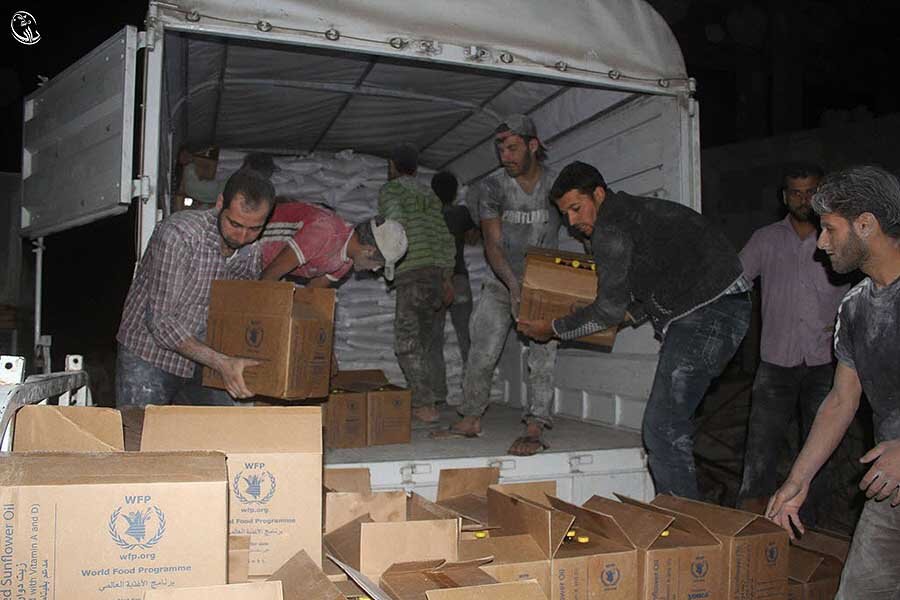After four years of siege, food aid reaches Damascus suburb
Loading...
| BEIRUT
After nearly four years of siege, first food deliveries have reached the Damascus rebel suburb of Daraya but government airstrikes were holding up the distribution of the aid on Friday, opposition activists said.
In northern Syria, Kurdish-led opposition fighters besieged the Islamic State-held town of Manbij on Friday in the climax to a Western-backed offensive that could see a major strategic victory in the region against the militant group.
Before surrounding Manbij, the predominantly Kurdish Syria Democratic Forces captured dozens of villages and farms around it in the past weeks, according to the Britain-based Syrian Observatory for Human Rights, which closely monitors the fighting in Syria.
SDF has been pushing in an offensive since late May in an attempt to capture the Islamic State's stronghold, one of its largest in Aleppo province. The Observatory said an IS commander from north Africa was killed in the latest round of fighting.
If the U.S.-backed SDF captures Manbij, it will be the biggest strategic defeat for IS in Syria since July 2015, when it lost the border town of Tal Abyad, a major supply route to the militants' de facto capital of Raqqa.
The Damascus suburb of Daraya, just southwest of the Syrian capital, has been under siege by government forces since November 2012 and has witnessed some of the worst bombardment during the country's civil war, now in its sixth year. Severe cases of malnutrition have been reported among its few thousand residents due to severe shortages of food and medicine.
Convoys organized by the Syrian Arab Red Crescent and the United Nations delivered the food from late Thursday into early hours of Friday, after the U.N. said the Syrian government had approved access to 15 of the 19 besieged areas within Syria.
SARC said the food delivery was coordinated with the U.N. in the Syrian capital. It said food, flour and medical supplies were delivered. The aid was placed in storage and activists and local council members were to deliver it during the day.
Last week, a joint convoy of the U.N., the International Committee of the Red Cross and SARC reached Daraya and delivered medicines, vaccines, baby formula, and "nutritional items for children" – but no food.
The U.N. estimates that there are currently 592,700 people living under siege in Syria, with the vast majority of them — some 452,700 people — besieged by government forces. Lifting the siege on rebel-held areas was a key demand by the opposition during indirect peace talks held in Geneva earlier this year.
But on Friday, the Observatory reported new government airstrikes and bombardment of Daraya. An opposition activist in Daraya said the government allowed only minimal amounts of food in order to create problems between the starving residents.
"Nothing has been distributed so far and the barrel bombs are falling on the city," said media activist Muhannad Abu al-Zein. "They allowed in food stuff for a quarter of the families here."
The U.N. estimates that 4,000 to 8,000 people live in Daraya, which has been subject to a crippling government blockade since residents expelled security forces in the early stages of the 2011 uprising against President Bashar Assad.
An official with the World Food Program said in a video posted online by Daraya activists that WFP delivered about 480 food rations that would feed about 2,400 individuals for one month.
The WFP official, who was not identified by the activists posting the video, said he had met with some beneficiaries of the food aid and community leaders. "Most families are having to do with one meal, which is not complete as a meal, per day in order to be able to get by," he said.
WFP said in a statement later Friday that a nine-truck convoy also brought in medical supplies and health items, and that the food boxes included rice, lentils, chickpeas, beans, bulgur, oil, salt and sugar.
A statement by the U.N. Office for the Coordination of Humanitarian Affairs, or OCHA, said the operation "proceeded smoothly" and was finished before dawn Friday.
"This delivery was successful but the U.N. continues to call for unconditional, unimpeded, and sustained humanitarian access to all people in need" throughout Syria, it said, adding that there are 4.6 million people currently living in hard-to-reach and besieged areas.
An amateur video posted online showed U.N. SUVs and white SARC trucks driving through sand barriers in the dark until they were met by opposition fighters. The video appeared genuine and corresponded to other AP reporting of the events.
Photographs posted online by activists in the suburb showed U.N. and SARC officials meeting local dignitaries and men removing WFP boxes from a white truck.
Among those joining the convoy into Daraya were the U.N. humanitarian coordinator for Syria, Yacoub El Hillo, and Khawla Mattar, a spokeswoman for the U.N. Special Envoy to Syria, Staffan de Mistura, according to photographs posted by local activists.







